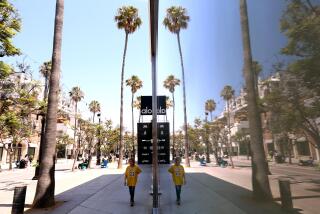Whittier Unveils Plans for âGrand Boulevardâ
Whittier officials are planning the cityâs most ambitious commercial redevelopment project since the 1987 earthquake that caused more than $90 million in damage and devastated local businesses and neighborhoods.
City planners say they expect the Whittier Boulevard Master Plan to transform the jumbled development on Whittierâs 7 1/2-mile section of the thoroughfare into a âgrand boulevardâ with five distinctly zoned segments: a gateway, business park, shopping district, auto mall and residential area.
Residents who attended the City Council meeting Dec. 17 saw dozens of slides depicting some of what could unfold along the street over the next 30 years, including a street lined with palm trees, new shopping centers, townhouses and an office district. The Whittier portion of the boulevard stretches from the San Gabriel River Freeway to the Orange County border.
âThis is very big. A lot of people have their hopes for Whittier pinned on the success of this plan,â said Charles Claver, 27, a lifelong resident.
âItâs forward-thinking. A lot of people want it right away,â said Arthur Rock, a 30-year resident.
To make the sweeping changes the plan calls for, Whittier would have to negotiate transfer of ownership for its section of the boulevard, which is a state highway controlled by the Department of Transportation.
The city also has to figure out which part of the project it wants to tackle first. Planners have suggested starting with the area proposed for shopping, which stretches from Washington Street to Laurel Avenue.
The beautification process, including street repairs and landscaping, could cost $8 million to $10 million. City officials said they have not identified funding sources to pay for any of the planned improvements.
Planning Commissioner Helen Rahder, a former councilwoman, said the projectâs goal is a far cry from what is on the boulevard now.
Side by side on one part of the street are a motel, beauty salon, restaurant, a tailor, an accountant, a pizza shop, furniture dealer and car repair shop.
âRight now, thereâs no rhyme or reason. Everything was zoned commercial, and folks just put things wherever they wanted to,â Rahder said. The result, she said, was a boulevard that didnât match the rest of the town of tree-lined streets, historic buildings and scenic hills.
With limited available space and access to only one major freeway at the edge of town, business in Whittier has struggled to compete with nearby cities such as Brea, La Habra and Montebello, city officials said.
âThe lack of freeway access is a negative, but the thing that probably hurts us to a greater degree is the lack of available land,â said City Manager Steve Helvey. âWe donât have 10 acres to put in a Costco or 50 acres to put in a shopping center.â
The economy and natural disaster also have hurt the city. Fifteen years ago, the quake caused substantial damage to about 5,000 homes and businesses. Hardest hit was the 52-block uptown area. When the smoke and dust cleared, 34 buildings housing 78 businesses had been destroyed or had to be demolished.
âWhittier used to be the place to shop, but all of a sudden Brea Mall, Puente Hills Mall and Montebello Town Center were the places to go,â said Ann Ybarra, the cityâs director of community development.
The Pico Rivera native said she had always wanted to live in Whittier, and moved to the city 10 days before the earthquake. âThe towns around Whittier were growing. Whittier got jealous,â she said.
The cityâs approach will be key to the planâs success, said Robert S. Harris, a fellow of the American Institute of Architects at USC.
âInstead of starting with the worst problems, you start strategically with the places that have the most chance of being valuable and successful,â said Harris, owner of Los Angeles-based Harris Architecture and Urban Design. âThen you take advantage of that success by trying to extend it to the adjacent areas.â
Michael Freedman, the planner who designed Whittier Boulevardâs proposed new look, warned against being too eager for change, adding that the vibrant urban design he envisioned for Whittier was at least 10 to 15 years away.
Still, officials are hoping the plan gets rid of what they consider general stagnation on the street. âThe development community drives through the city,â Councilman Allan Zolnekoff said. âThey want to know: Is the city on the way up or on the way down?â
More to Read
Sign up for Essential California
The most important California stories and recommendations in your inbox every morning.
You may occasionally receive promotional content from the Los Angeles Times.










